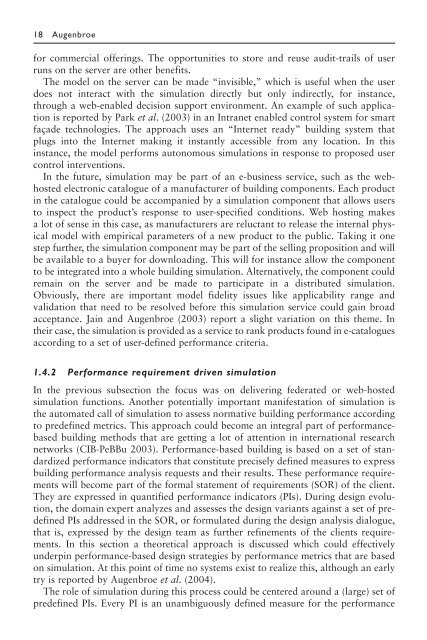Advanced Building Simulation
Advanced Building Simulation
Advanced Building Simulation
Create successful ePaper yourself
Turn your PDF publications into a flip-book with our unique Google optimized e-Paper software.
18 Augenbroe<br />
for commercial offerings. The opportunities to store and reuse audit-trails of user<br />
runs on the server are other benefits.<br />
The model on the server can be made “invisible,” which is useful when the user<br />
does not interact with the simulation directly but only indirectly, for instance,<br />
through a web-enabled decision support environment. An example of such application<br />
is reported by Park et al. (2003) in an Intranet enabled control system for smart<br />
façade technologies. The approach uses an “Internet ready” building system that<br />
plugs into the Internet making it instantly accessible from any location. In this<br />
instance, the model performs autonomous simulations in response to proposed user<br />
control interventions.<br />
In the future, simulation may be part of an e-business service, such as the webhosted<br />
electronic catalogue of a manufacturer of building components. Each product<br />
in the catalogue could be accompanied by a simulation component that allows users<br />
to inspect the product’s response to user-specified conditions. Web hosting makes<br />
a lot of sense in this case, as manufacturers are reluctant to release the internal physical<br />
model with empirical parameters of a new product to the public. Taking it one<br />
step further, the simulation component may be part of the selling proposition and will<br />
be available to a buyer for downloading. This will for instance allow the component<br />
to be integrated into a whole building simulation. Alternatively, the component could<br />
remain on the server and be made to participate in a distributed simulation.<br />
Obviously, there are important model fidelity issues like applicability range and<br />
validation that need to be resolved before this simulation service could gain broad<br />
acceptance. Jain and Augenbroe (2003) report a slight variation on this theme. In<br />
their case, the simulation is provided as a service to rank products found in e-catalogues<br />
according to a set of user-defined performance criteria.<br />
1.4.2 Performance requirement driven simulation<br />
In the previous subsection the focus was on delivering federated or web-hosted<br />
simulation functions. Another potentially important manifestation of simulation is<br />
the automated call of simulation to assess normative building performance according<br />
to predefined metrics. This approach could become an integral part of performancebased<br />
building methods that are getting a lot of attention in international research<br />
networks (CIB-PeBBu 2003). Performance-based building is based on a set of standardized<br />
performance indicators that constitute precisely defined measures to express<br />
building performance analysis requests and their results. These performance requirements<br />
will become part of the formal statement of requirements (SOR) of the client.<br />
They are expressed in quantified performance indicators (PIs). During design evolution,<br />
the domain expert analyzes and assesses the design variants against a set of predefined<br />
PIs addressed in the SOR, or formulated during the design analysis dialogue,<br />
that is, expressed by the design team as further refinements of the clients requirements.<br />
In this section a theoretical approach is discussed which could effectively<br />
underpin performance-based design strategies by performance metrics that are based<br />
on simulation. At this point of time no systems exist to realize this, although an early<br />
try is reported by Augenbroe et al. (2004).<br />
The role of simulation during this process could be centered around a (large) set of<br />
predefined PIs. Every PI is an unambiguously defined measure for the performance

















